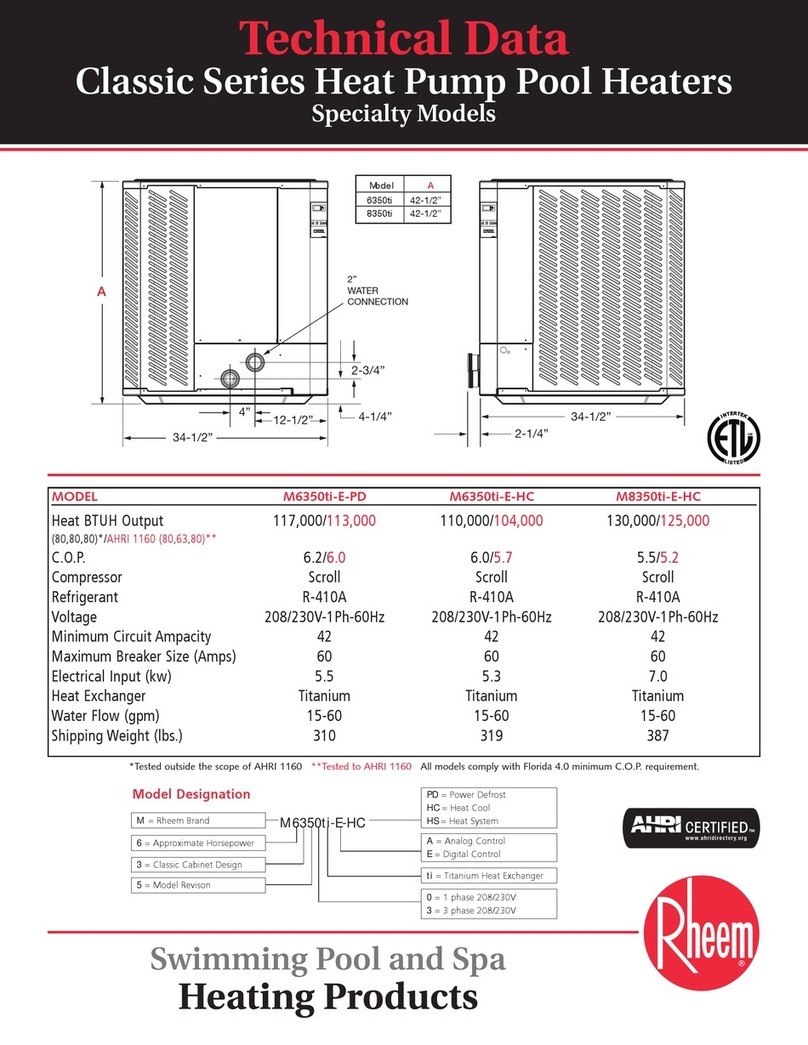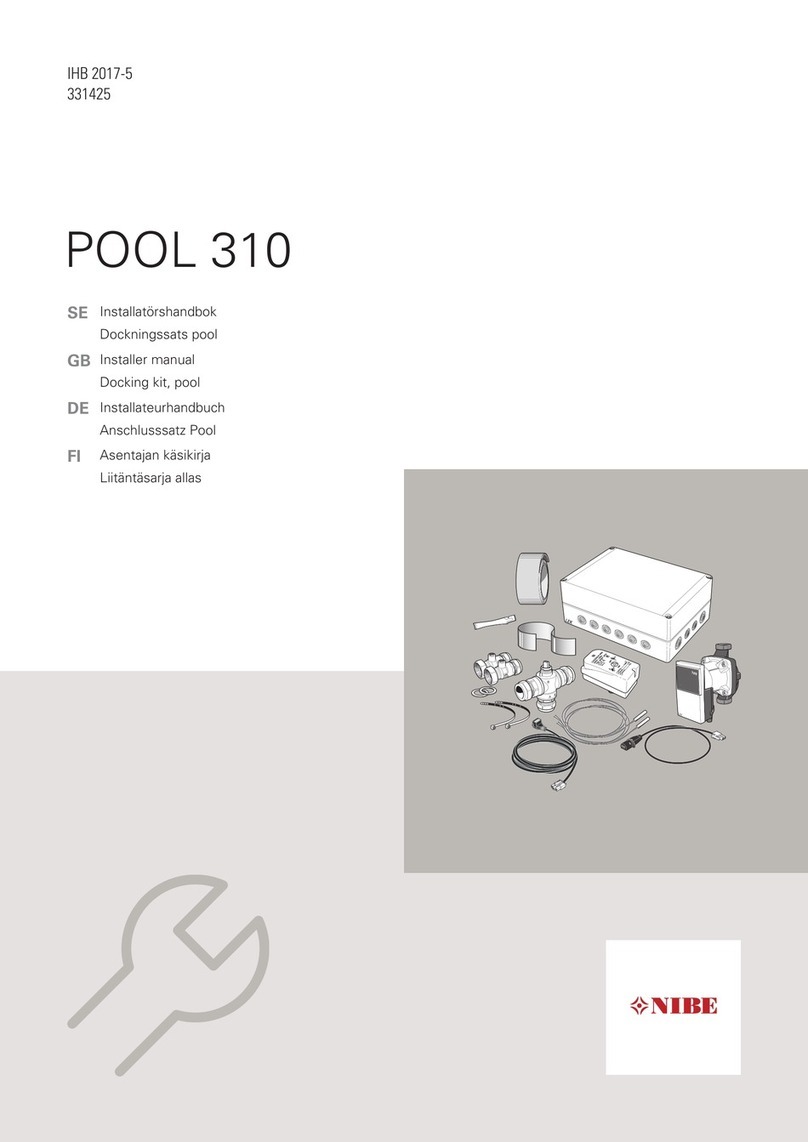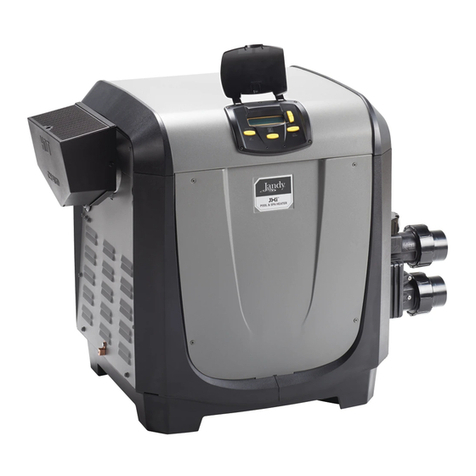TTI Pool Heat Pump User manual

POOL HEAT PUMP
OWNER’S MANUAL
INSTALLATION MANUAL
No : 2004.1
GENERATION MODEL ECLIPSE MODEL
READ THESE INSTRUCTIONS CAREFULLY BEFORE INSTALLING OR
USING YOUR NEW POOL HEAT PUMP.

TABLE OF CONTENTS
Introduction...............................................................................................p.3
ACost-EfficientHeater
How Does It Work?
LowMaintenance
Selecting the location.................................................................................................p.4
Supply andAccessibility
Other Recommendations for Spas
WaterInletandOutletConnections..............................................................p.5
Basic Connection
Chlorinators, Brominators and Other Automatic Systems
Pressure-Type Chlorinator or brominator
In-line Chlorinator or Brominator
Salt Chlorinator
Dual Units Connection
PoolandSpa Connection............................................................................p.8
Using One Pump and One Filter for the Pool and the Spa
Using Independent Pumps and Filters for the Pool and the Spa
ElectricalConnection..................................................................................p.9
Maintenance...........................................................................................p.10
Cleaning
Winterizing
Seasonal Start-up
Water Deviation
WaterMaintenance.....................................................................................p.13
Why Perform Water Maintenance?
Water Chemistry
Sanitizers
What to Do?
Swimming Pool Heat Pump Control.....................................................p.18
SolvingProblems........................................................................................p.24
QuestionsandAnswers.............................................................................p.25
Warranty..................................................................................................p.26

A Cost-efficient Heater
Your newpoolheatpumpwill helpyousavemoney comparedtoothertypesofpoolheat-
ers. In fact, even if your pool heat pump has a lower heat capacity which makes it run for 24
hoursaday,thepoolheatpump remainsthemosteconomicsystem, becauseoftheuseofstate
oftheart technicsinthermodynamics.
How Does It Work?
Yourpoolheatpumpworksjustasawaterpumpdoes. Whereasawaterpumpistranferring
waterfromoneplace toanother,your poolheatpumpis transferringheatbetweenthe surround-
ingairandyourpoolwater. Moreover,yourpoolheatpumpisnotproducingheatwith theenergy
it is consuming just as a water pump is not producing water. It is because of this principle that
yourpool heat pumpmay attain efficiencyratios going upto 600% or700% in thebest climatic
conditions. Thismeans thatfor each kilowattyour poolheater consumes,it istransfering 6or 7
kilowattsfromthesurrounding airtothe poolwater. Thedifferenceisastronomicalcomparedto
oil,gas or electricresistance heatersyielding only80 to95%output. But itis trueto saythatthe
outputof traditionalpool heatersstays constantat anyoutdoor climatic conditions whereas the
outputof apool heatpump varies. However, even whentemperatures arecooler thepool heat
pumpcontinuesto transferheat betweenair and waterand itstays thebestchoice fortempera-
turesdownto 5Celcius (41Fahrenheit) overnight.
Low Maintenance
Your pool heatpump is designedfor lower maintenanceat a lower cost. But ifyou want
yourpool tobeheated efficiently,youmustfollow theadvice supplied inthis manual.
INTRODUCTION
3

SELECTING THE LOCATION
The area you choose for your pool heat pump is very important. You must consider the
following.
Air Supply and Accessibility
Yourheat pumpuses thesurroundingair towork. It isveryimportantthatyou makesure
there is enough air circulation around the heat pump. Do not install the heat pump in a closed
space like a garden shed, a garage, or a basement.
Thetablebelowindicatestheminimumdistancefromtheheatpumpthatanyobjectshould
belocated.
Other Recommendations
Donotinstalltheheatpumpunderaroof. Doingthiswill protect theheatpumpfrombeing
buriedbysnow orreceiving heavyrainfall from theroof thatdoes nothavegutters.
Also,make sure thatthe digital controldoes not facethe sun. The controlwill not break
butits digital display will be more difficult to read.
Ifyouhaveanautomated sprinklersystemforyourlawn, makesurethattheheat pumpis
notshoweredby asprinkler.
The pool heat pump should be installed on a firm and leveled surface, preferably on a
concreteslabor somethingequivalent.
Keep in mind that the heat pump will cause condensation. Therefore water will be drip-
pingfromthe heatpump.
11
2
3
2
21
4
4
3
Generation (CP) Eclipse (MP)
(1) facing the coil surfaces 2 feet = 61 cm 2 feet = 61 cm
(2) facing other surfaces 10 inch = 25.4 cm 14 inch = 35.5 cm
(3) facing fan * 4 feet = 122 cm 4 feet = 122 cm
(4) facing service panel 2 feet = 61 cm or accessible 2 feet = 61 cm or accessible
* Objects should be placed as far as possible from where the air is discharged.
CP Model MP Model
4

WATER INLET AND OUTLET CONNECTIONS
For all Eclipse (MP) models, connection pipes are 1 1/2 inches in diameter. For all
Generation(CP) models, theconnection pipes are2 inches indiameter. For all the pool
heaters,we recommend(obligatory forthe Eclipse series)the installationof aset ofvalves
allowingto isolatethe poolheater from thefiltration systemwhen necessary. (Seethe drawing
below.) Moreover, youhaveto makesure thatyour poolheat pumpmay bedisconnected from
thepool pipeswithout havingto stopthe waterpump orwithout losinggreat quantitiesof water.
Toadjustthewaterflow goingthroughthepoolheater,pleaseadjusttheby-passvalve(a)
inthefollowingway:
MP30 - MP50 : 3/4 opened
MP70 : 1/2 opened
AllCP’s:Closed-the internalcalibratedvalve regulatesthewater flow, exception
for those who have a water pump of 2hp or greater, adjust the valve to obtain the flows listed
below.
If the previous settings are not respected, the pump or the pool heater may be over-
chargedandresult infailure ofyourequipement.
Your water pumpmust provide thequantity of waterindicated inthe table below. These
numbersmustbe usedfor eachpoolheat pumpinstalled. A flowmetermust beinstalled onthe
waterinletofthe poolheatertoknow theexactwaterflow. Caution:manyflowmeters requirea
longdistance ofstraight tubingon theinlet sideto offeran adequatemeasurement.
Foryourown security,andtoensureproper operationofthe unit,thewaterconnec-
tionmust beperformed by aqualified personas per allapplicable national,provin-
cial, state or local codes.
Minimum Ideal Maximum
Eclipse 15 GPM(US) 20-30 GPM(US) 50 GPM(US
)
Generation 25 GPM(US) 40-50 GPM(US) 65 GPM(US
)
Front View
W
ater Outlet
Water Inlet Setof valves a
a
GMP(US): Americangallons (3,78l)per minute
5
Table of contents
Popular Swimming Pool Heater manuals by other brands
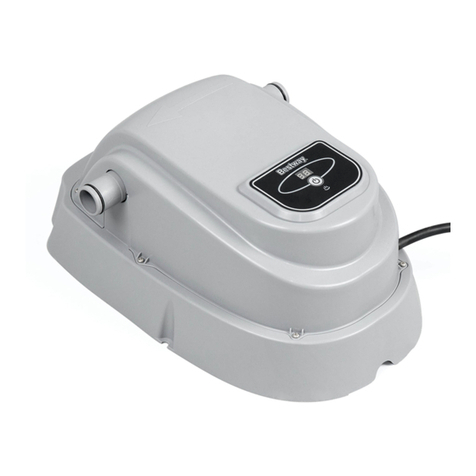
Bestway
Bestway 58259 owner's manual
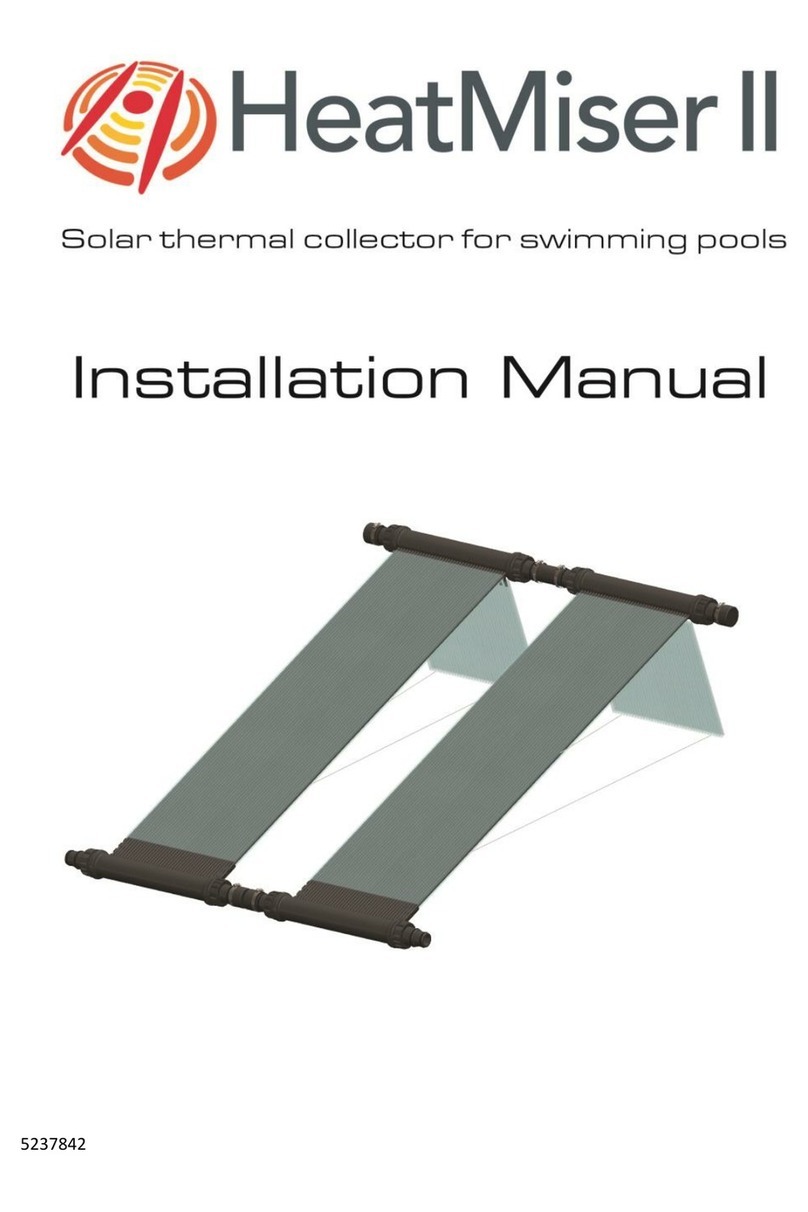
Maytronics
Maytronics HeatMiser II installation manual

Certikin
Certikin MB50S Operating, installation and servicing instructions

Jandy
Jandy PRO Series JXI200 Quick reference guide
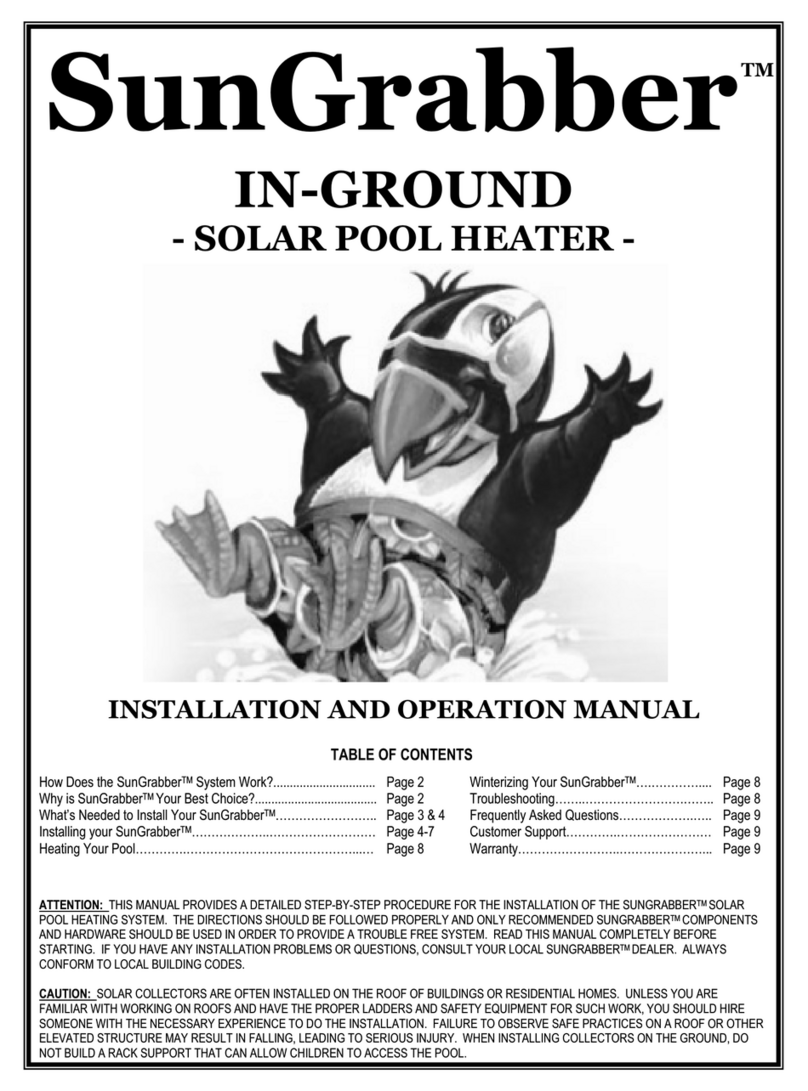
Sungrabber
Sungrabber IN-GROUND Installation and operation manual
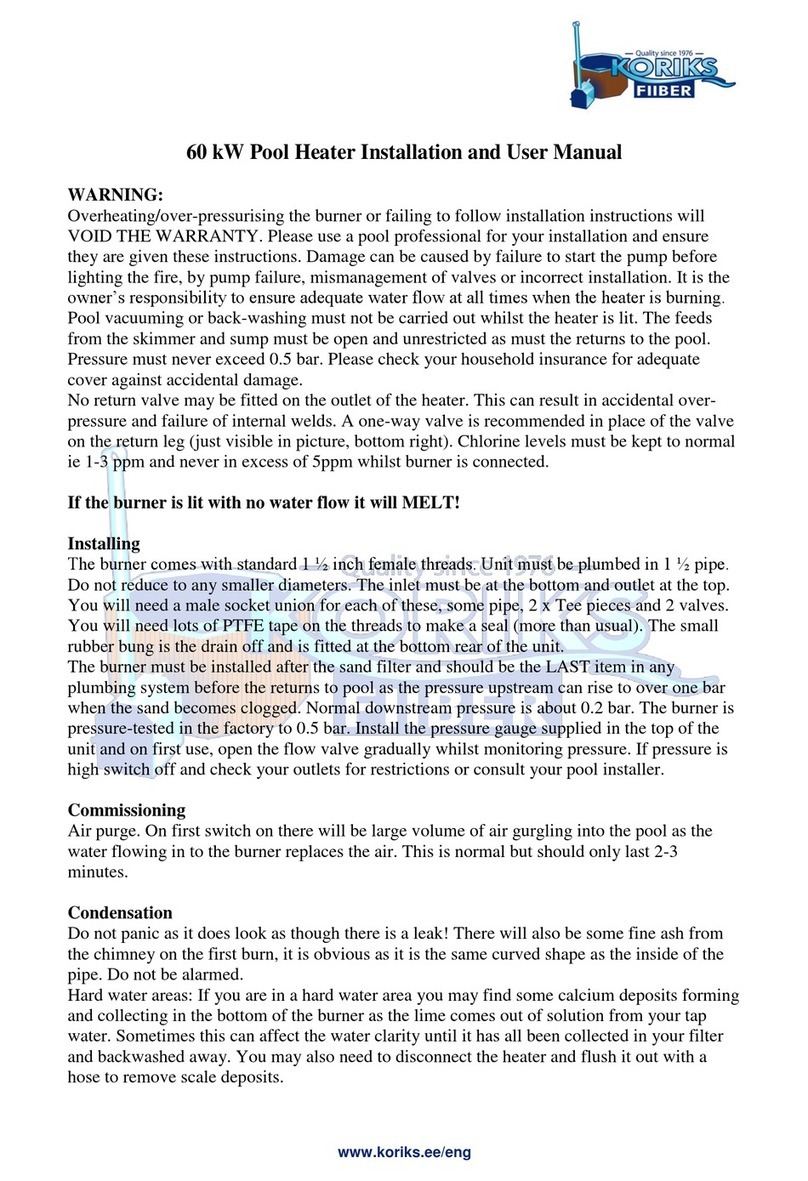
Koriks
Koriks 60 kW pool heater Installation and user manual

T.I.P.
T.I.P. SPH 10000 Translation of original operating instructions

SIRAIR
SIRAIR ZSXP07i User and service manual

EcoOnline
EcoOnline PoolMasterpro Installation and user manual
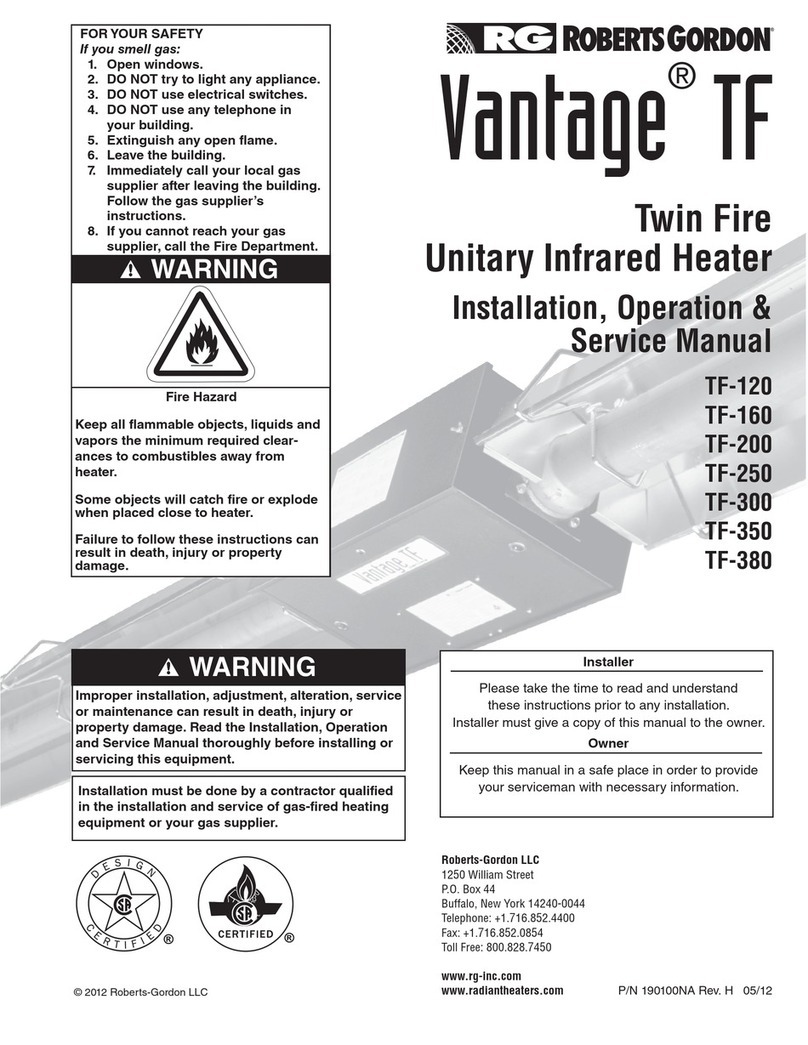
Roberts Gorden
Roberts Gorden Vantage TF-120 Service manual

HydroTherm
HydroTherm 42 installation instructions
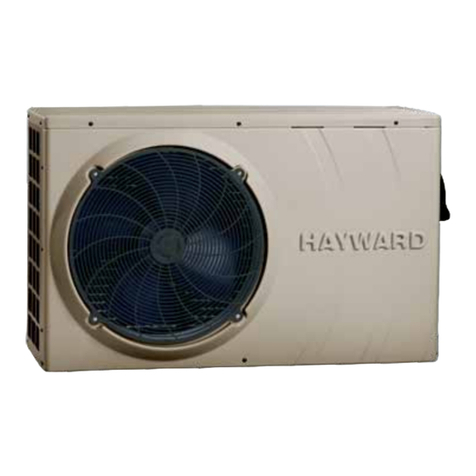
Hayward Pool Products
Hayward Pool Products HP40A Installation instructions manual
